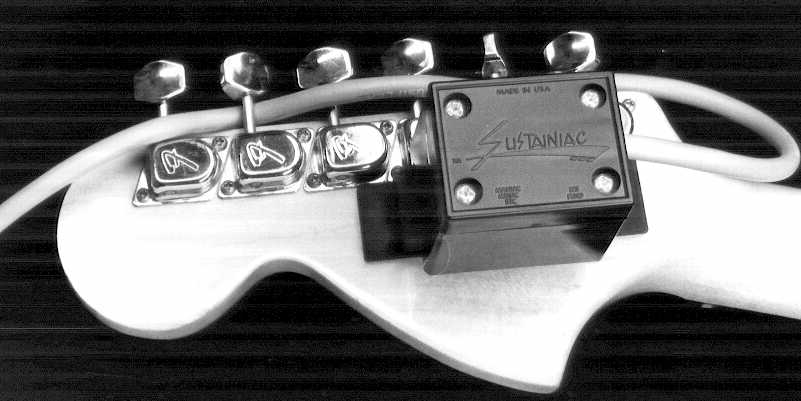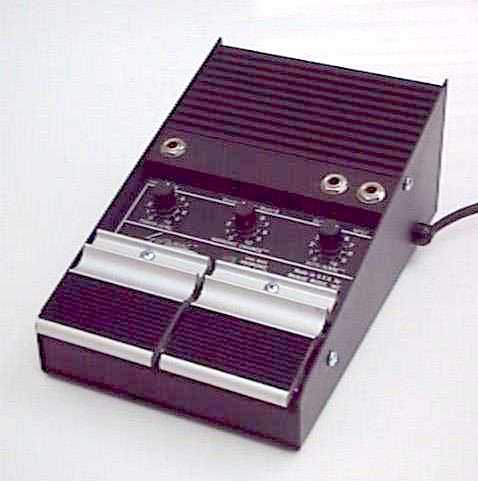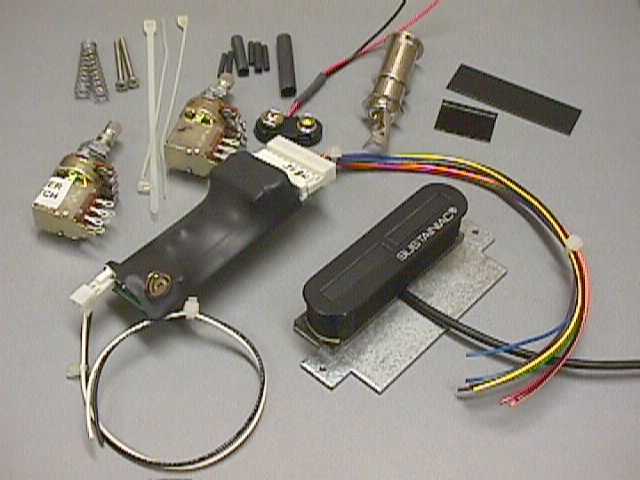Home (amp tone and effects placement)
Maniac Music - Sustainiac Model C & Model B
Model C - News, Oct. 2003
From: Hoover Alan (HooverA at tce com), Tue, 3 Dec 2002: "The Model C is coming along. I'm predicting that here will be a few units available by the end of the year [2002]. But don't consider that a promise! -- Alan"
· The Model C has a dedicated effects loop-out directly in front of the power amp in the Model C. (The loop doesn't go to your guitar amp etc. It is only there for the sustainer.) You can insert a volume control or graphic eq for the sustainer there.
· The Model C transducer clamps on with a thumbscrew. There are no magnets to glue onto the headstock.
· There is a smaller cord
· Has a new cord-routing system.
Model B
Jan 2003: "the Sustainiac Model B sustainer has been discontinued. For the last 13 years, we at Maniac Music Inc. have sold the Model B to the world's most creative guitar players. ... We at Maniac Music have been developing a new and even better acoustic-type sustainer for several years now. Several major refinements have been made to replace the Model B. The new model ... will be introduced in the coming months. It will be worth the wait."
My review at Harmony Central -- Basically easy to use. It's unclear what the difference is between the outer knobs; it seems like a couple intensity knobs could be combined into one. Attaching the driver to the headstock is a problem and an issue. I tried double-side tape, but at one point the sharp-edged magnet fell and damaged the paint. I recommend rubber coating the edges of the magnet. The cable is cumbersome. The cable is made of a terrible, grabby/sticky type of rubber, and puts up a fight -- hard to manage. It seems to kick in too suddenly, which is why I went out of my way to rig up a volume pedal to create a more natural, gradual onset of feedback. Aside from the too sudden attack and extreme either on or off feedback, the unit produces a convincing simulation of speaker-to-strings feedback. I recommend a pedal being built into the unit, or a circuit to prevent sudden on-off behavior; it should fade in, not kick in. The manufacturer should use a more conventional cable coating that's not grabby/sticky, build in a circuit or pedal to prevent sudden attack onset of feedback, and coat the magnet so it's not sharp, and provide a good way of temporarily attaching the magnet to any guitar.
Sustainiac company responds:
About the cord on the Model B: We used a good Belden microphone wire for that. But when it ages, it gets gooey. You can wipe this off with rubbing alcohol. Just soak a rag in rubbing alcohol, rub the cable, then wipe it off. The goo will go away.
Details on how the Model B controls work: Keep in mind that there is an AGC circuit (automatic gain control) that tends to find a constant output level. It is actually a limiter to prevent amplifier clipping, yet keep the gain high. If a note is responding robustly, the gain turns down. If a note is slow to take off, the gain turns up. In our design process in the mid-80's, we found that this circuit produced a more responsive sustainer than other arrangements we tried.
POWER LEVEL control: This actually sets the power amplifier gain. If you turn it down, only a limited amount of power will be applied to the driver. You can use this to provide slow buildup of sustain.
AUTO SENSE: This actually sets the maximum preamp gain. If you turn it down, then the AGC gain can only go up so high. Keep in mind that the Auto-sense control and the AGC tend to "fight" each other.
If you use double-stick tape on the Model B transducer, you defeat the whole purpose of the transducer. We take pains to point out in the owners manual that a direct metal-to-wood contact is necessary to transfer vibration energy from transducer to headstock. Use a heavy rubber band if you want a temporary mounting. Best, use silicone adhesive, applied thinly, then press it down so that metal contacts wood. If you use double-stick tape, the tape absorbs the vibration energy, rendering the transducer virtually useless.



Maniac Sustainiac - Both types of string-driving sustainer/feedback circuit are now available as add-ins, without having to buy a complete guitar. Feedback is a key part of authentic cranked-amp tone, and this technology enables adding feedback at private playing levels. Sustainers are also highly controllable.
The headstock model is bulkier but enables using the neck pickup with the sustainer circuit engaged.
Maniac Sustainiac -- official product page. Informative. Now both electromagnetic and acoustic circuits are available, as add-ons for your existing guitars.
jonnra, below, is working on a sustainer circuit. He wrote:
>Michael,
>Here is a site that has some samples of sustainer technology. It is very similar to the music I am currently making.
driver-pickup sustainer circuits and samples
>Another interesting thing on this Hamer is a pickup circuit called the "Sustainiac". I am sure, some of you guitareros have already heard about this. Or better: you played it!! With this "pick", you can create a (endless!!! until batteries are empty) sustain!! On "Little blond...." i used this guitar just for FX sounds, made with this "Sustainiac". So i guess that many of you didn't recognize some sounds as a guitar!!! (Well, with a little help from a Harmonizer)
http://www.guitarmag.com/issues/9710/ indicates that the Sustainiac was reviewed in Guitar Magazine October 1997 - VOLUME 14 - No. 12 , "Gear Factory" column.
http://www.hikarate.com/hamer/guit1.html -
Californian (1987 - 1997) - Downsized contoured body with scalloped offset double cutaways, bolt-on maple neck (25.5 inch scale length) with angled peghead, 27 frets on a dot-inlay rosewood fingerboard. Fitted with one humbucker and one single coil pickup and Floyd Rose trem. The Elite version has upgraded pickups (OBL, EMG or Seymour Duncan), ebony fingerboard, boomerang inlays and optional figured maple body. The Custom version is as the Elite but has a glued-in neck with a sculpted neck/body joint. Also sometimes fitted with Sustainiac circuitry (circa 1990 only). There are also 12-String and double-neck (6 + 12) versions.
Chaparral (2nd version) (1987 - 1994) - the Standard version is as above but has a bolt-on neck (with a modified peghead) and a 25.5" inch scale length. The Elite has optional figured maple- top, ebony fingerboard, boomerang inlays and upgraded pickups. The Custom is essentially the same as the 1st version but has a 25.5 inch scale-length. Also sometimes fitted with Sustainiac circuitry (circa 1990 only). All are fitted with 5-way switch and side mounted output jack. Single humbucker versions are also seen. 12-string Chaparral has a glued-in neck. Web page about a custom version of this guitar: http://www-students.biola.edu/~chrisw/IC/chaparral.html - "This is also the last Hamer built with a Sustaniac in it, as the company which made the Sustaniac went under." [might be back in business now]
Amptone.com ultra gear-search page
Home (amp tone and effects placement)